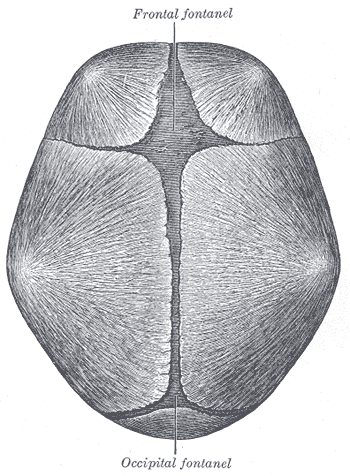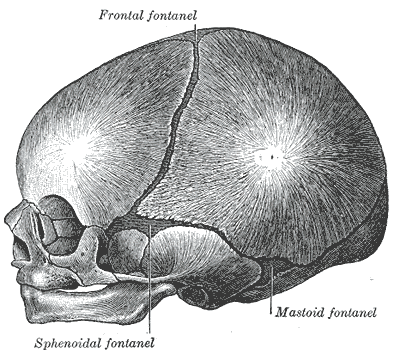Fontanelle
 |
 |
Editor-In-Chief: C. Michael Gibson, M.S., M.D. [1]
In human anatomy, a fontanelle (or fontanel) is one of two "soft spots" on a newborn human's skull. There are, however, two more fontanelles of interest, the mastoid fontanelle, and the sphenoidal fontanelle.
Fontanelles are soft spots on a baby's head which, during birth, enable the soft bony plates of the skull to flex, allowing the head to pass through the birth canal. Fontanelles are usually completely hardened by a child's second birthday, and will eventually form the sutures of the neurocranium.
The skull of a newborn consists of five main bones: two frontal bones, two parietal bones, and one occipital bone. These are joined by fibrous sutures, which allow movement that facilitates childbirth and brain growth.
At birth, the skull features a small posterior fontanelle, an open area covered by a tough membrane, where the two parietal bones adjoin the occipital bone (at the lambda). This fontanelle usually closes during the first several months of an infant's life.
There is also a much larger, diamond-shaped anterior fontanelle where the two frontal and two parietal bones abut. This fontanelle remains open until the child is about two years of age. In cleidocranial dysostosis it is often late in closing or never closes.
The anterior fontanelle is useful clinically. Examination of an infant includes palpating the anterior fontanelle. A sunken fontanelle indicates dehydration, whereas a very tense or bulging anterior fontanelle indicates raised intracranial pressure.
Parents may worry that their infant may be more prone to injury at the fontanelles. In fact, although they may colloquially be called "soft-spots", the membrane covering the fontanelles is extremely tough and difficult to penetrate.
The fontanelles allow the infant brain to be imaged using ultrasonography. Once they are closed, most of the brain is inaccessible to ultrasound imaging, as the bony skull presents an acoustic barrier.
References
de:Fontanelle it:Fontanella (anatomia) he:מרפס nl:Fontanel qu:Ñup'u sv:Fontanell zh-yue:腦囟